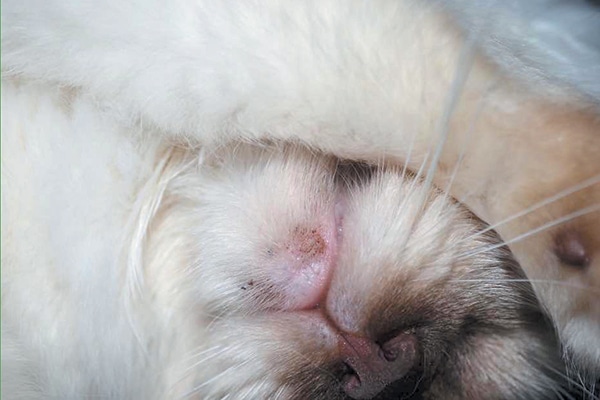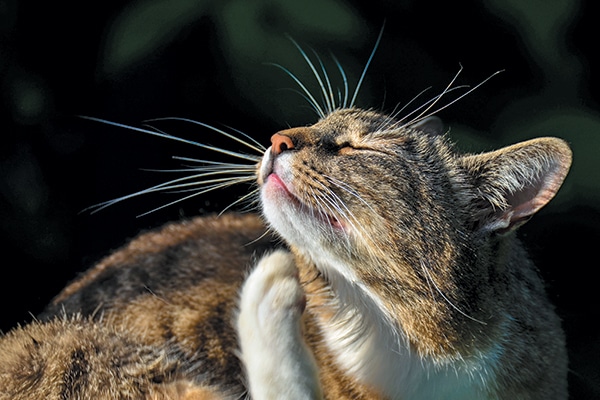For most of us, the word acne conjures up images of pimply-faced adolescents. For veterinarians, however, the word triggers images of fuzzy-faced felines with dirty chins. Feline acne is a disorder of the hair follicles. It’s often referred to as “chin acne” because the chin is the most commonly affected area, although the adjacent lower lip and sometimes the upper lip may be involved. Unlike in humans, feline acne is not confined to adolescence in cats; a cat of any age can have cat acne. There is no particular breed susceptibility, and there may be a slight gender predilection for males.
Feline acne is a common disorder. It can vary in severity, from mild to severe. Mild cases may show slight hair loss, a few dark crusts and the presence of a few comedones (that’s the fancy medical term for blackheads). These mild cases usually bother the owner more than the cat, as it looks like the cat has a dirty chin. Many cats remain in this mild stage. Others, however, may progressively begin to develop redness, pimples, pustules, itching and swelling. In very severe cases, firm, infected nodules develop on the chin, accompanied by swelling and thickening of the skin. Sadly, these nodules can be very painful, making cats uncomfortable. Making the diagnosis is fairly straightforward. Diagnostic tests are rarely necessary; this is a clinical diagnosis.
Feline Acne Treatments

Cat acne is treatable, although the treatment usually manages the disorder rather than cures it. Feline acne treatment is based on the severity of the condition. Mild cases of cat acne may not need any treatment at all, although most owners find the condition unsightly and prefer to treat. Treatment of mild cases involves the use of topical gels or ointments. A variety of products are available, but do not use products designed for humans on your cat, unless specifically approved by your veterinarian. A common first choice is a product containing benzoyl peroxide, a broad-spectrum antibacterial agent that also helps with itching and helps flush out the hair follicles. Clipping the hair on the chin can improve the efficacy of topical therapy, as does the application of warm compresses before applying the ointment. By soaking the area, comedones are softened, promoting drainage.
If a bacterial infection is suspected (for example, if pustules are present), a topical antibiotic ointment might be a more appropriate choice. Again, a variety of products are available. My personal first choice is mupirocin, which is very effective against two of the common bacterial offenders, staph and strep.
Severe cases of cat acne, in which there are multiple painful, draining pustules, require systemic antibiotics. Once again, there are many treatment options available. My preference is amoxicillin-clavulanic acid (Clavamox); however, there is an injectible antibiotic formulation called cefovecin (Convenia) in which one injection under the skin provides an entire 14-day course of treatment and is especially useful in cats that resent oral medication (i.e., every cat on Earth).
The good news about feline acne is that the prognosis is excellent. However, treatment may be lifelong, requiring maintenance topical medication. While cats are not thrilled with having ointment smeared on their chins, most tolerate it well, allowing those formerly dirty little chins to return to their pristine state.
Whys & Whats of Feline Acne
The cause of feline acne is not clearly understood.
- Occasionally, microscopic examination of skin scrapings from the area reveals the presence of a mite called Demodex. Whether this parasite is a cause or a complicating factor is difficult to say.
- Culturing the exudate from the pustules on the chin may reveal the presence of yeast and/or bacteria but, again, it isn’t clear whether this is a primary or a contributing cause.
- Plastic food dishes have been implicated in feline acne, with the theory being that the plastic causes a contact hypersensitivity, making the skin more susceptible to inflammation and infection. It is now thought that the bacterial levels found on the plastic dishes are more to blame than the plastic itself. Using glass, ceramic or metal bowls for feeding may help, as will cleaning the bowls often.
Read more about cat acne on Catster.com >>
Thumbnail: Photography ©Sitkka | Thinkstock.
Dr. Arnold Plotnick is the founder of Manhattan Cat Specialists, a feline-exclusive veterinary practice on Manhattan’s upper west side. He is also an author of The Original Cat Fancy Bible. Dr. Plotnick is a frequent contributor to feline publications and websites, including his own blog, Cat Man Do. He lives in New York City with his cats, Mittens and Glitter.
Editor’s note: Have you seen the new Catster print magazine in stores? Or in the waiting area of your vet’s office? Click here to subscribe to Catster and get the bimonthly magazine delivered to your home.
Dealing with acne yourself? Discover ways to non-toxic acne care >>
Read more about cat health on Catster.com:








